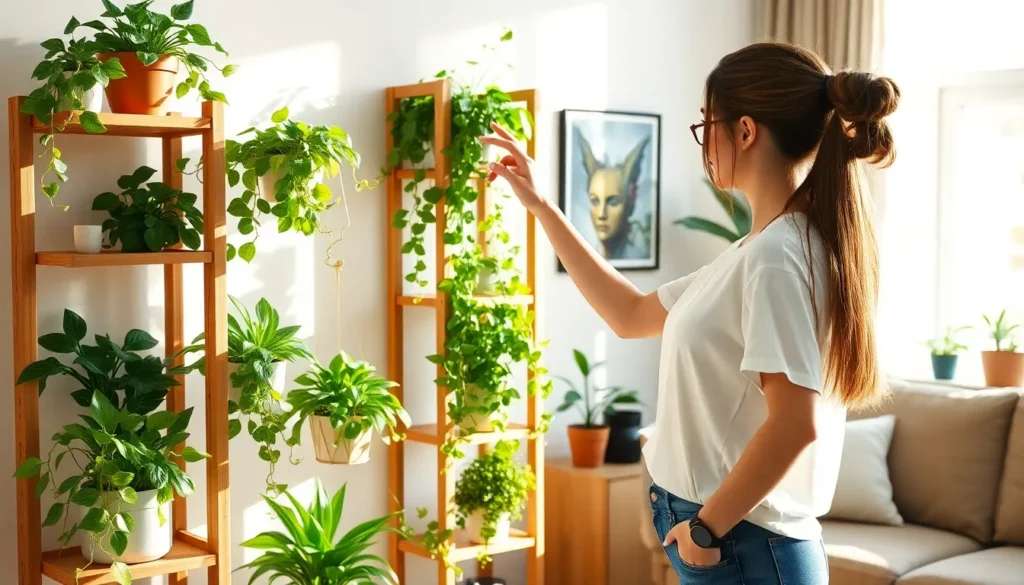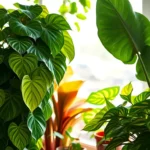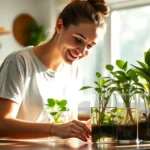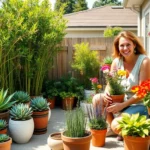We’ve all been there – staring at our collection of beautiful houseplants scattered across windowsills and coffee tables while dreaming of a more organized and stunning display. Indoor plant shelves transform cluttered spaces into breathtaking vertical gardens that maximize your growing potential without sacrificing precious floor space.
The right shelving system doesn’t just organize your green friends; it creates an impressive living focal point that elevates your entire home’s aesthetic. Whether you’re working with a tiny apartment or a spacious living room we’ll show you how strategic plant shelving can turn any corner into your personal indoor oasis.
From sleek modern designs to rustic wooden ladder shelves the options are endless when it comes to showcasing your plant collection. We’re diving deep into the most effective shelving answers that’ll help you create the Instagram-worthy plant paradise you’ve always wanted while keeping your leafy companions healthy and thriving.
Choose the Right Material for Your Indoor Plant Shelves
Material selection determines both the longevity and aesthetic appeal of your indoor plant shelving system. We’ll examine three popular materials that each offer distinct advantages for housing your green companions.
Wood Shelving Options for Natural Appeal
Wood shelves create warmth and complement the organic nature of your indoor plants beautifully. Cedar, teak, and bamboo resist moisture naturally, making them ideal choices for humid plant environments. Pine and oak provide budget-friendly alternatives that work well when properly sealed with water-resistant finishes.
Natural wood grains add texture and visual interest to any room while supporting substantial plant weight. Reclaimed wood shelves bring character and sustainability to your indoor garden setup. Maintenance requires periodic sealing to prevent water damage from plant watering and humidity.
Customization becomes easier with wood materials since you can cut, stain, or paint them to match your existing décor. Floating wooden shelves create clean lines while ladder-style wooden units maximize vertical growing space efficiently. We recommend checking weight capacity ratings before loading shelves with heavy ceramic planters.
Metal Shelves for Modern Durability
Metal shelving systems handle heavy plant collections without sagging or warping over time. Powder-coated steel and aluminum resist rust and corrosion from plant watering moisture. Industrial-style metal frames support multiple tiers while maintaining structural integrity under substantial weight loads.
Wrought iron shelves add decorative flourishes that complement both modern and traditional home styles. Stainless steel options provide sleek, professional appearances perfect for contemporary interiors. Galvanized metal finishes offer superior protection against humidity and occasional water splashes.
Adjustable metal shelving allows you to modify spacing as your plants grow taller or wider. Most metal units feature drainage-friendly designs with open frameworks that promote air circulation around your plants. Assembly typically requires minimal tools, and many systems expand with additional components as your collection grows.
Glass Shelves for Minimalist Design
Glass shelving creates an illusion of floating plants while maximizing natural light distribution throughout your display. Tempered glass handles important weight loads safely while remaining virtually invisible in your room design. Clear surfaces don’t compete with your plants’ natural beauty or existing décor elements.
Cleaning glass shelves takes minutes with standard glass cleaners, maintaining crystal-clear visibility of your plant collection. Thickness matters when selecting glass shelves, with 8mm to 12mm providing optimal strength for most houseplants. Safety considerations include rounded edges and proper mounting hardware to prevent accidents.
Light transmission through glass shelves benefits lower-tier plants by allowing overhead illumination to reach multiple levels. Frosted or tinted glass options provide subtle design variations while maintaining the minimalist aesthetic. We suggest avoiding glass shelving in high-traffic areas where breakage risks increase significantly.
Consider Weight Capacity and Structural Support
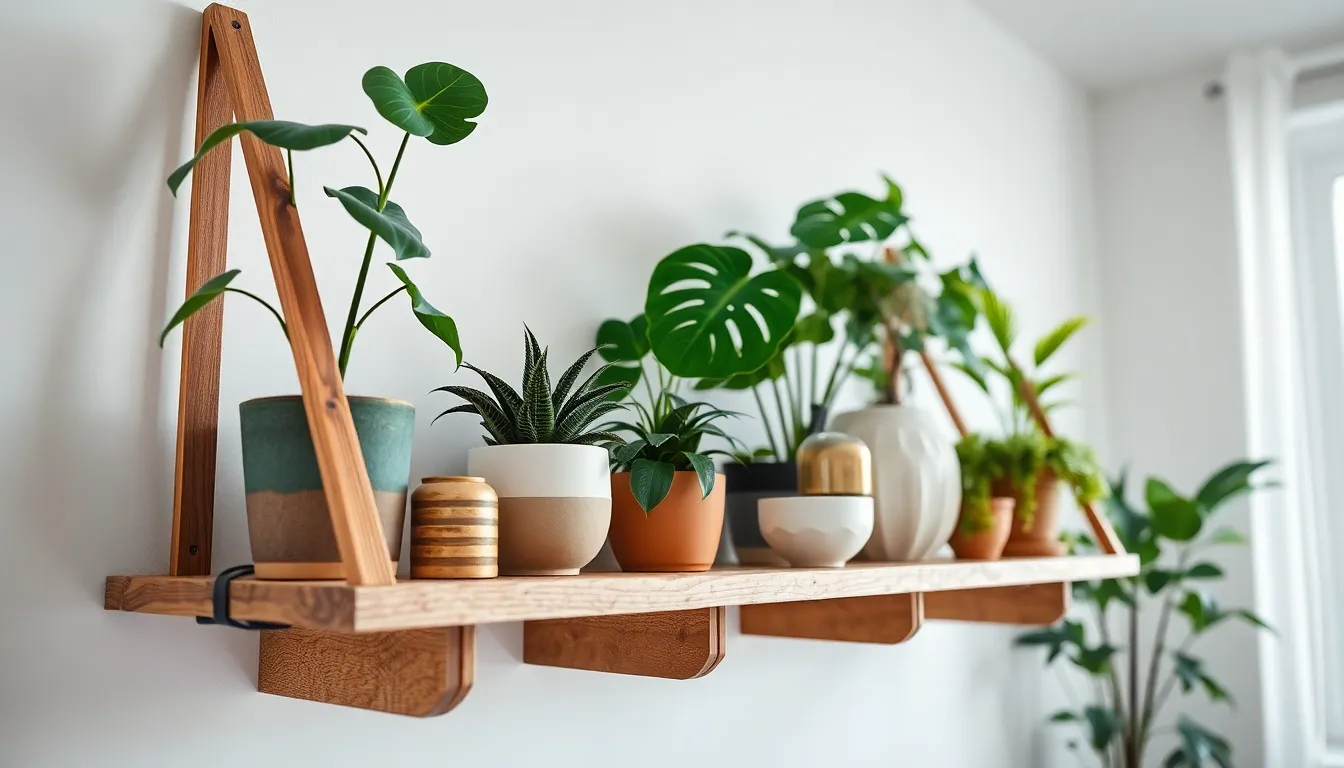
Weight capacity serves as the foundation for safe plant shelf selection, especially when displaying multiple specimens or larger potted plants. Our shelving systems must support not only decorative pots but also the substantial weight of moist soil and growing plants.
Calculate Plant and Pot Weight Requirements
Start by weighing your empty containers to establish a baseline measurement. Terra cotta pots typically weigh 2-5 pounds empty, while ceramic planters can reach 8-15 pounds depending on size and thickness.
Add the weight of fully saturated soil to your calculations since watering significantly increases total load. A standard 10-inch pot holds approximately 8-12 pounds of moist potting mix, while larger 14-inch containers can contain 20-25 pounds of soil.
Factor in your plant’s mature weight when selecting shelving capacity. Small succulents add minimal weight, but mature fiddle leaf figs or monstera plants can contribute an additional 5-10 pounds to the total load.
Include a 50% safety margin in your weight calculations to accommodate plant growth and seasonal watering variations. If your pot and plant combination weighs 20 pounds, we recommend shelving rated for at least 30 pounds per section.
| Plant Size | Empty Pot Weight | Soil Weight | Plant Weight | Recommended Shelf Capacity |
|---|---|---|---|---|
| Small (6-8″) | 1-3 lbs | 3-5 lbs | 1-2 lbs | 15 lbs minimum |
| Medium (10-12″) | 3-6 lbs | 8-12 lbs | 3-5 lbs | 30 lbs minimum |
| Large (14-16″) | 6-10 lbs | 20-25 lbs | 5-10 lbs | 60 lbs minimum |
Ensure Proper Wall Mounting for Heavy Loads
Locate wall studs for maximum support when installing floating shelves or bracket systems. Standard drywall anchors support only 20-30 pounds, while stud mounting can handle 78-100+ pounds per shelf as commonly available in major retailers.
Choose heavy duty wall anchors rated for your exact wall type and expected load. Toggle bolts work well in hollow walls and can support 50-75 pounds, while concrete anchors handle even heavier loads in masonry walls.
Verify mounting hardware specifications match your shelf’s weight capacity and intended use. Professional grade brackets and screws should exceed your calculated plant weights by at least 25% for long term safety.
Consider professional installation for built in shelving systems or when mounting multiple heavy shelves. Built in units require structural assessment to determine safe load limits, especially in older homes with varying construction standards.
Test stability before loading your newly installed shelves with plants. Gently apply pressure and check for any movement or flex that could indicate insufficient support or improper installation.
Select Shelves with Proper Drainage Solutions
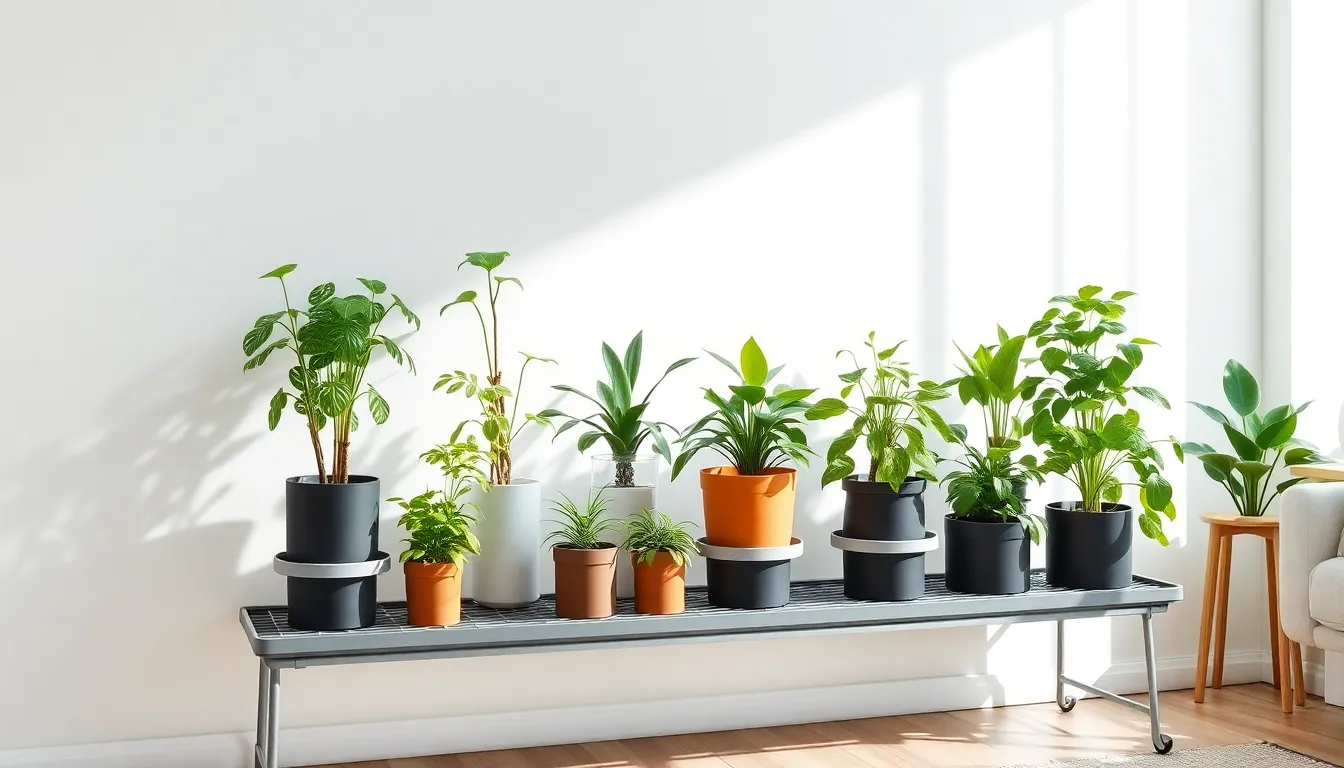
We need to prioritize drainage features when choosing plant shelves to prevent water damage and maintain healthy growing conditions. Proper water management systems protect both our plants and our home’s surfaces.
Built-in Drip Trays and Water Management
Built-in drainage systems offer the most comprehensive water management solution for indoor plant displays. These specialized shelves feature integrated trays or troughs that automatically collect excess water during watering sessions. Materials like pond liner can be added to these trays and filled with gravel to enhance water flow while preventing root rot conditions.
Advanced designs incorporate angled shelving surfaces that naturally direct water into collection buckets without requiring plant relocation. Pipe or tubing systems connect these built-in trays to designated containers below the shelving unit. This gravity-driven approach eliminates water spillage onto floors and furniture while maintaining a clean growing environment.
Water collection systems work continuously to protect our home surfaces from moisture damage. The automated drainage prevents standing water accumulation that often leads to pest attraction and mold growth. These integrated answers make plant care more efficient by reducing cleanup time after watering sessions.
Removable Saucers for Easy Maintenance
Removable saucers provide flexible drainage options that accommodate different pot sizes and plant needs. We can easily lift these trays to empty collected water and inspect for signs of overwatering or drainage issues. Individual saucers under each plant pot allow for customized water management based on exact plant requirements.
Cleaning becomes straightforward when saucers detach completely from the shelving system. Regular maintenance involves removing accumulated water to prevent stagnant conditions that harbor bacteria and insects. These portable answers let us check plant health without disturbing root systems or disrupting growth patterns.
Maintenance schedules become more manageable with removable drainage components. We can rotate clean saucers while washing others, ensuring continuous protection for all plants. This modular approach adapts to changing plant collections and seasonal watering adjustments throughout the year.
Position Shelves for Optimal Light Exposure
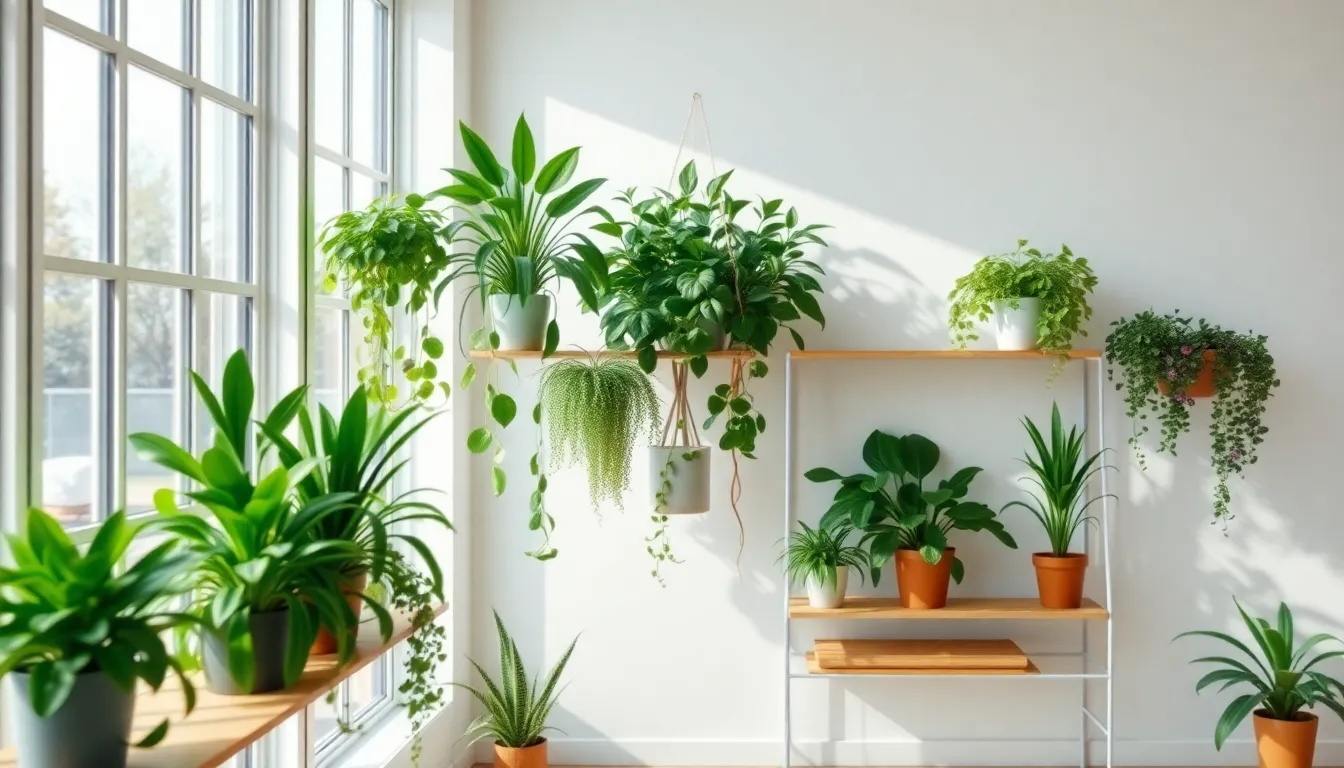
Strategic placement of your plant shelves determines the success of your indoor garden. Light exposure becomes the critical factor that transforms struggling plants into thriving green displays.
We recommend locating your plant shelves in areas that receive abundant natural light, ideally near windows or under skylights providing bright, indirect light. Such placement ensures plants get necessary illumination for photosynthesis and vitality. Multiple levels or staggered heights allow you to layer plants according to their size and light needs—taller or light-loving plants can be placed at the top or back, with smaller or shade-tolerant varieties at lower levels or front.
Wire or open material shelves maximize light penetration and provide excellent air circulation to all plants. This design also facilitates misting or humidifying when your plants need extra moisture.
Near-Window Placement Strategies
Positioning shelves as close to large windows as possible makes use of natural light without exposing plants to harsh direct sunlight that may scorch leaves. North-facing or east-facing windows often provide balanced indirect light ideal for many indoor plants.
Corner spaces by windows create impactful displays that combine light access with space efficiency. We’ve found this arrangement particularly effective for maximizing both natural illumination and floor space utilization.
Grouping plants with similar light requirements together on shelves near the window optimizes growing conditions for each species. Adjusting their placement based on how much light each variety prefers creates microclimates that support healthy growth patterns.
Supplement with Grow Lights When Needed
Rooms with insufficient natural light or darker winter months require artificial grow lights to ensure plants receive adequate light intensity and spectrum for growth. Installing grow lights above or integrated into the shelf system provides customized illumination for your exact plant collection.
Combining natural light by windows with grow lights extends growing hours and improves plant health, especially for light-demanding species. This dual approach maintains consistent photosynthesis rates regardless of seasonal changes or weather conditions.
Advanced grow light systems can be programmed to supplement natural light automatically, adjusting brightness and duration based on available sunlight throughout the day.
Maximize Vertical Space with Multi-Tier Designs
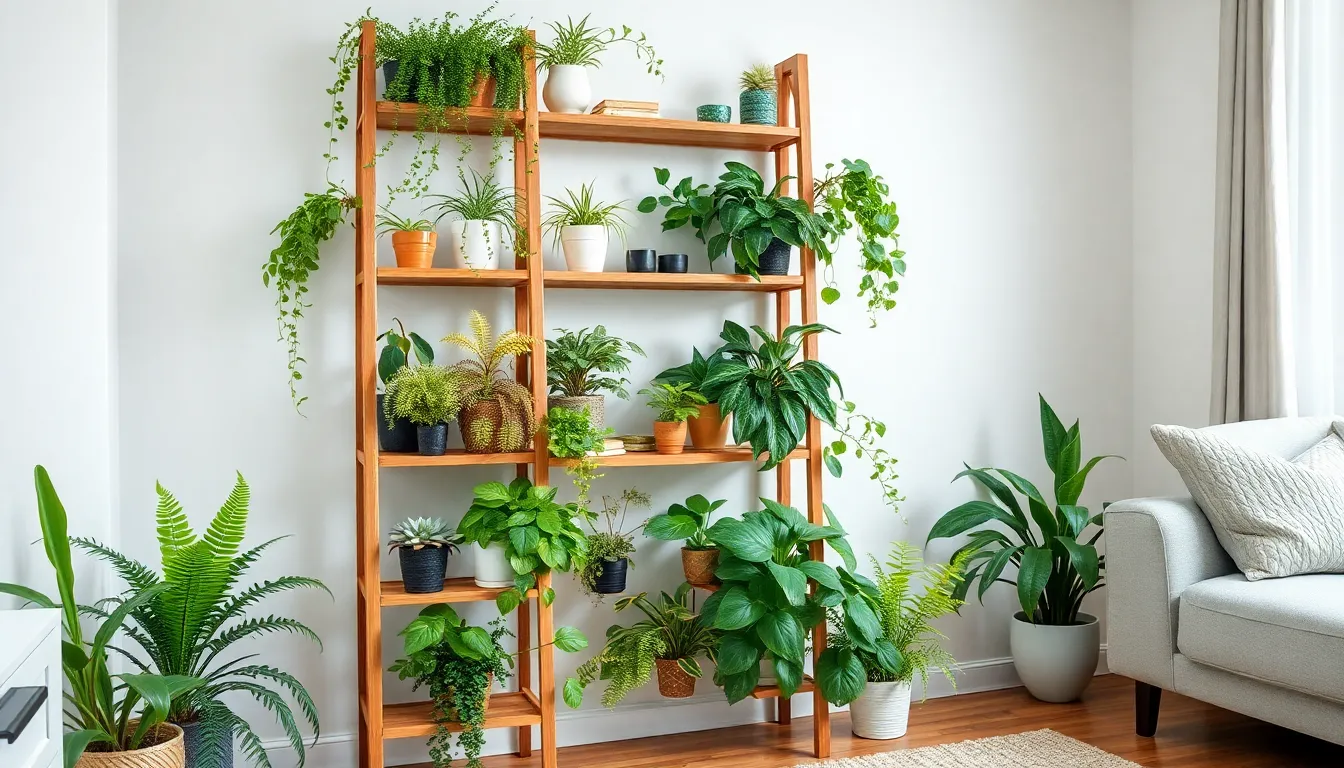
Multi-tier shelves transform empty wall space into stunning vertical gardens that showcase your entire plant collection. These vertical stacking systems allow you to display many plants without sacrificing precious floor space in your home.
Floor-to-Ceiling Ladder Shelves
Floor-to-ceiling ladder shelves lean against your wall to create impressive vertical displays that draw the eye upward through cascading greenery. These tall, narrow units provide multiple tiers for plant placement while taking up minimal floor area in even the smallest spaces.
Efficient vertical wall usage makes these shelves perfect for apartments and compact rooms where every square foot counts. You’ll find flexibility to arrange various plant sizes, with small pots positioned on upper tiers and larger specimens placed at the bottom for stability.
Styling options let you combine plants with decorative items like books, candles, or small art pieces for a personalized touch. This approach creates visual interest while maintaining the primary focus on your green collection.
Weight distribution works naturally with ladder shelves since heavier plants sit lower, providing better balance and reducing stress on wall mounting points. The graduated placement also ensures adequate light reaches plants at different levels.
Corner Plant Stands for Space Efficiency
Corner plant stands fit snugly into overlooked room corners, transforming these dead spaces into vibrant green focal points. These specialized stands often feature circular, triangular, or tiered designs customized specifically for corner placement.
Space optimization turns unused corners into productive growing areas that don’t interfere with foot traffic or furniture placement. You’ll maximize every inch of your room while creating dedicated plant zones that feel intentional and organized.
Compact footprint design allows you to mix plants of different shapes and sizes while maintaining organization within a confined area. These stands accommodate trailing plants that can cascade down multiple levels, creating natural curtain effects in corners.
Focused green nooks emerge when you group complementary plants together in corner arrangements. This clustering approach helps establish microenvironments where plants with similar care requirements can thrive together.
Flexible sizing options mean you can choose stands that accommodate everything from small succulents to medium-sized houseplants, adapting to your collection’s changing needs over time.
Incorporate Adjustable Shelving Systems
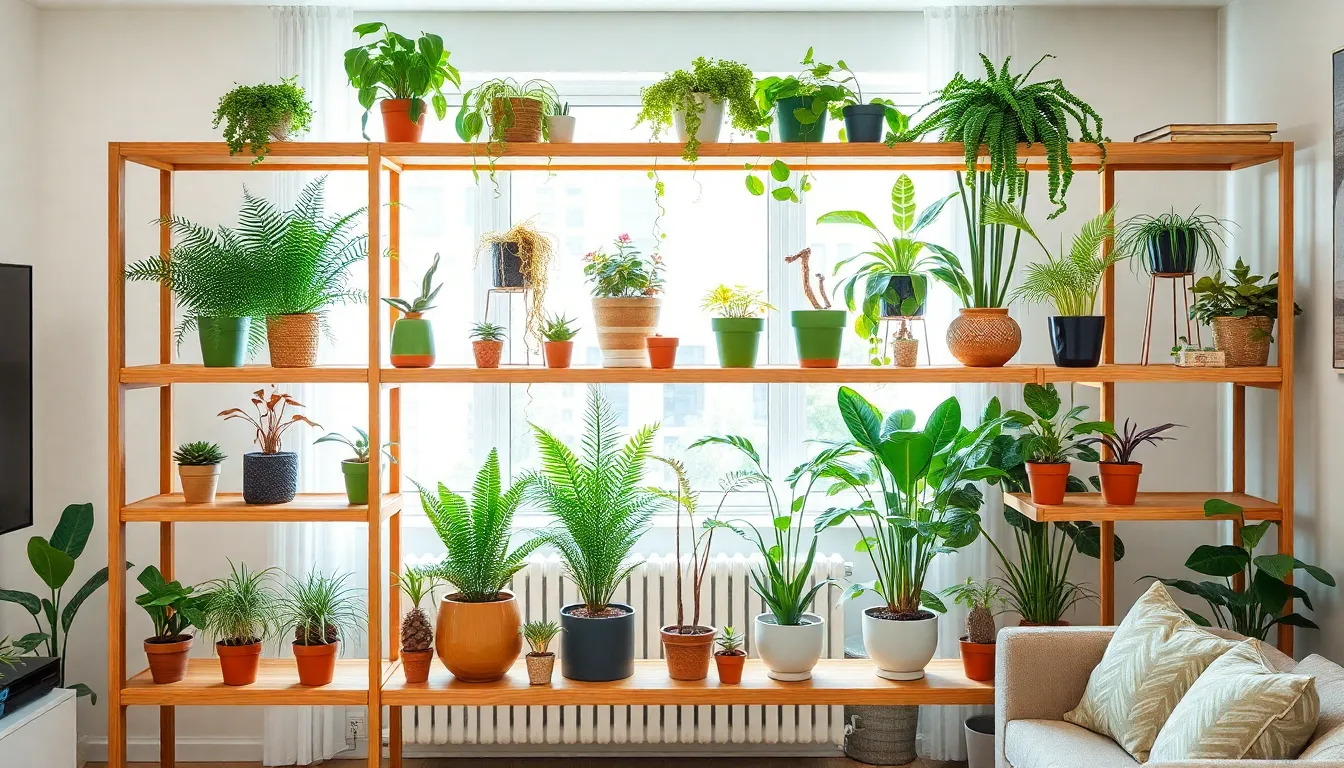
Adjustable plant shelves transform your indoor garden by adapting to your plants’ changing needs throughout their growth cycles. These versatile systems eliminate the guesswork of spacing while maximizing your vertical growing space.
Customizable Height Options for Plant Growth
Adjustable height features allow us to accommodate plants ranging from 8 inches to over 80 inches tall within the same shelving unit. Metal, wood, and bamboo materials offer multi-tiered designs with clip-on spacers and sliding mechanisms that reposition effortlessly as our plants mature. Strategic height adjustments optimize light exposure for each plant while preventing overcrowding issues that stunt growth.
Sliding mechanisms enable us to increase or decrease shelf spacing without tools or complex installations. Clip-on spacers provide precise positioning options that accommodate both tall statement plants and compact succulents on the same stand. Customizable spacing ensures our growing collection receives proper air circulation and prevents leaves from touching adjacent surfaces.
Modular Components for Future Expansion
Modular designs support our expanding plant collections by accepting additional shelves, hanging rods, and rolling bases without replacing the entire system. Stackable components integrate seamlessly with existing setups while maintaining structural integrity across all configurations. Multi-functional bottom shelves provide extra storage for plant care supplies and decorative elements that enhance our display aesthetics.
| Component Type | Expansion Options | Benefits |
|---|---|---|
| Extra Shelves | Stackable tiers | Increased plant capacity |
| Hanging Rods | Vertical extensions | Air plant display options |
| Rolling Bases | Mobile platforms | Easy repositioning |
| Corner Sections | Angled additions | Space optimization |
Floor plant stands with expandable features accommodate our future acquisitions while maintaining organized arrangements. Tiered racks accept additional layers that transform basic setups into impressive vertical gardens. Foldable shelves collapse for seasonal storage while expanding quickly when we need extra display space for new plant purchases.
Choose Shelves That Match Your Home Decor
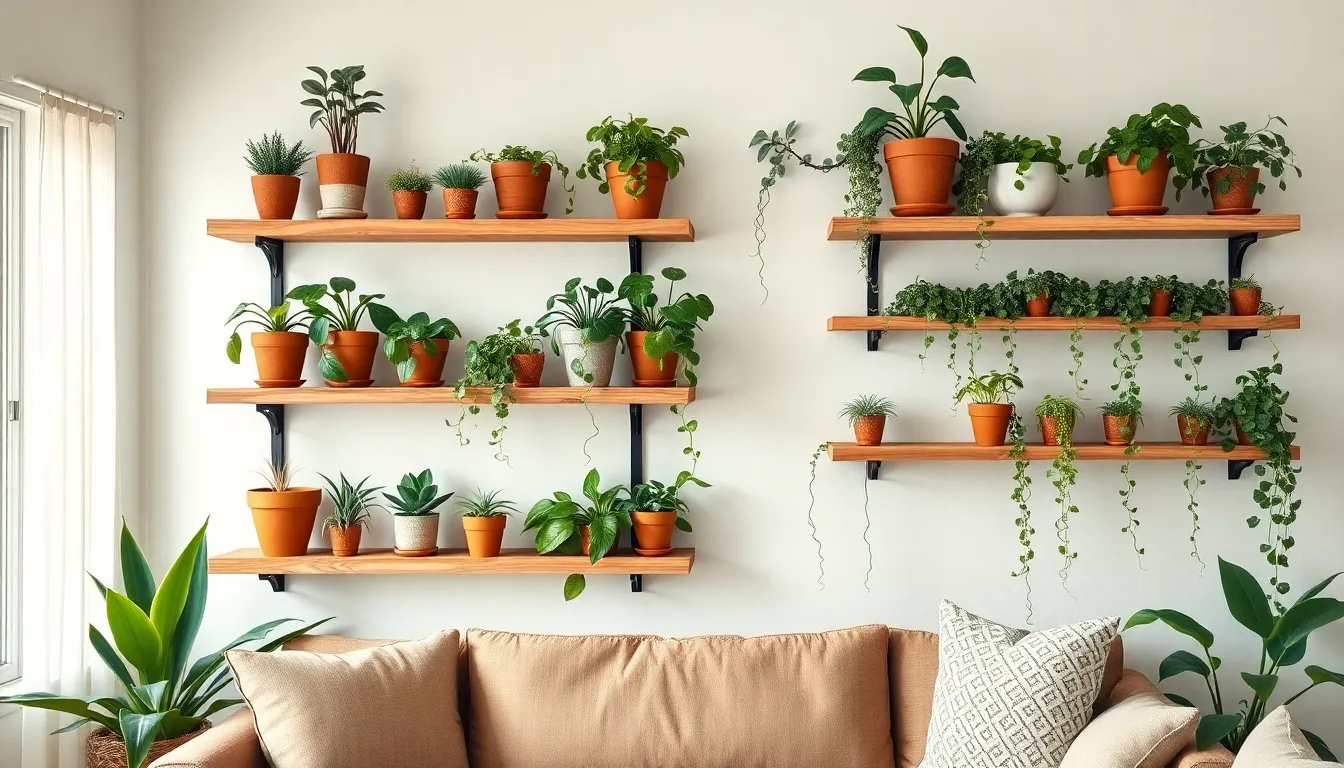
We believe selecting plant shelves that complement your existing interior design creates a harmonious living space. The right shelf style can elevate your indoor garden while seamlessly blending with your home’s aesthetic.
Rustic Farmhouse Plant Shelf Styles
Rustic farmhouse shelves feature natural wood with distressed finishes that perfectly complement cozy, vintage-inspired interiors. These shelves emphasize earthy tones and sturdy construction, creating a warm backdrop for your plant collection. We recommend pairing these wooden displays with terracotta pots or woven baskets to enhance the organic feel.
Tiered wooden shelves offer excellent functionality for this style, providing multiple levels for plants of varying sizes. Ladder-style units create charming vertical displays that maximize space while maintaining that homey farmhouse appeal. The natural wood texture adds warmth to any room and develops beautiful patina over time.
Distressed finishes on these shelves blend seamlessly with weathered furniture and vintage decor elements. We find that the robust construction typical of farmhouse designs easily supports heavier plant collections without compromising stability.
Contemporary Floating Shelf Designs
Contemporary floating shelves create sleek, minimalist displays that appear to “float” without visible brackets. These modern designs use smooth wood, metal, or acrylic materials to achieve clean lines that complement contemporary decor. We love how these shelves showcase plants in an organized, uncluttered fashion.
Floating shelves work exceptionally well for smaller plants or trailing varieties like string of hearts and philodendrons. These cascading plants create elegant displays as they flow naturally from the shelf edges. The streamlined design prevents visual competition between the shelf and your plants.
Staggered arrangements of floating shelves add visual interest while maintaining the minimalist aesthetic. Linear configurations work equally well for those preferring symmetrical displays. We recommend these shelves for modern homes where clean design and functionality take priority over ornate details.
The invisible mounting system creates the illusion of plants floating on walls, making rooms appear larger and more open. This design approach works particularly well in smaller spaces where traditional shelving might feel overwhelming.
Ensure Proper Air Circulation Around Plants
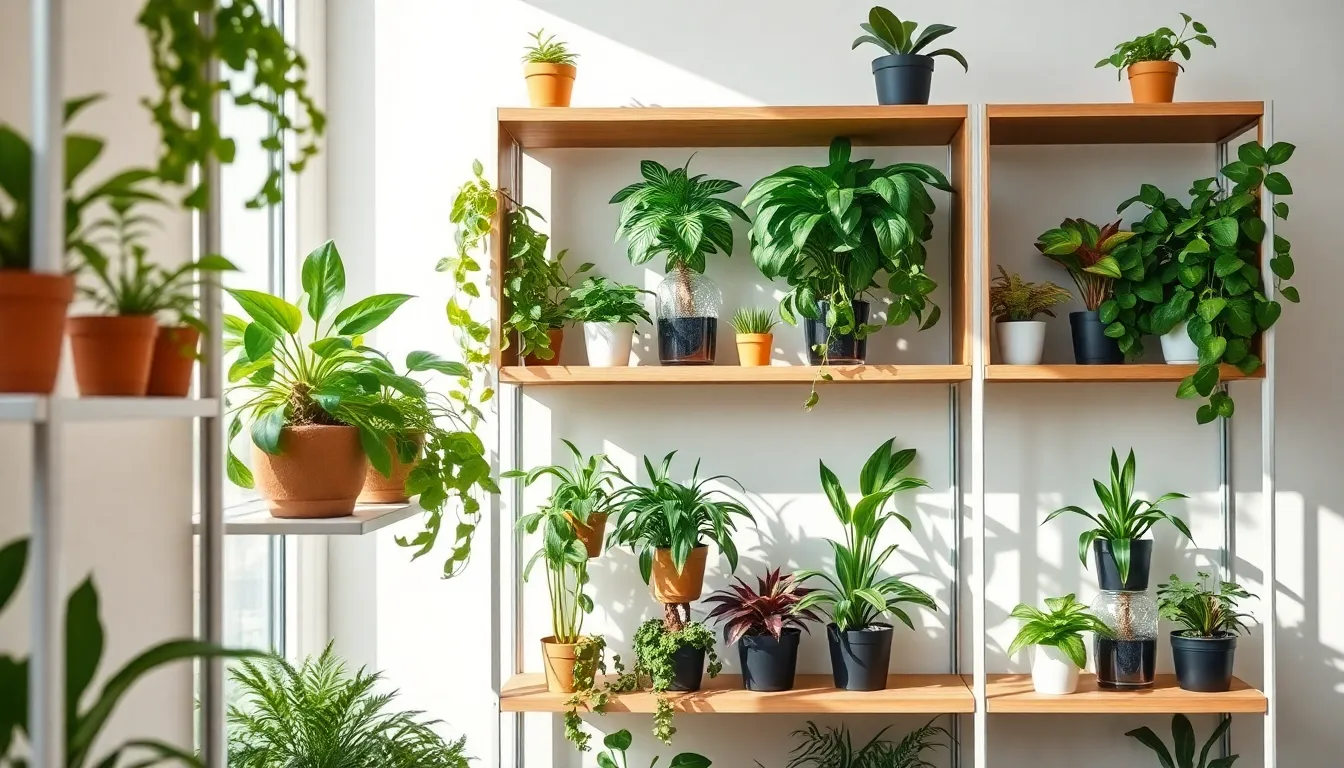
Proper airflow is essential for maintaining healthy indoor plants and preventing common issues like mold, pests, and disease. When we elevate plants off the floor using shelves, we immediately improve air circulation around our green companions while reducing humidity buildup that can harm plant health.
Spacing Requirements Between Shelf Levels
Adequate vertical spacing between shelf levels prevents overcrowding and ensures our plants receive proper air movement. Experts recommend leaving several inches of space above each plant to help airflow and prevent leaves from touching the shelf above, which can cause moisture buildup and disease.
Crowded arrangements restrict both airflow and light penetration, creating conditions where stagnant air becomes trapped around our plants. We should calculate spacing based on our tallest plants’ mature height, adding extra room for natural growth patterns and seasonal changes.
Adjustable shelving systems offer the flexibility we need to customize spacing for different plant sizes and airflow requirements. These systems allow us to modify shelf heights as our plant collection grows and changes, ensuring optimal air circulation throughout the year.
Open-Back Designs for Better Airflow
Open-back shelf designs significantly improve ventilation compared to fully backed shelves by allowing air to flow from all sides. Multi-tiered or ladder-style shelves with open spaces between levels encourage airflow around plants on each shelf, preventing the stagnant air conditions that can harm our indoor gardens.
Shelves without back panels or with minimalistic support frames promote better ventilation while making it easier to position units near windows. This strategic placement maximizes light exposure while maintaining crucial airflow behind our plants, creating the ideal growing environment.
Wire frame constructions and floating shelf arrangements work exceptionally well for maintaining air circulation in smaller spaces. These designs can be wall-mounted or positioned as ladder-style units that lean against walls while keeping the back area completely open to air movement.
Install Safety Features for Household Protection
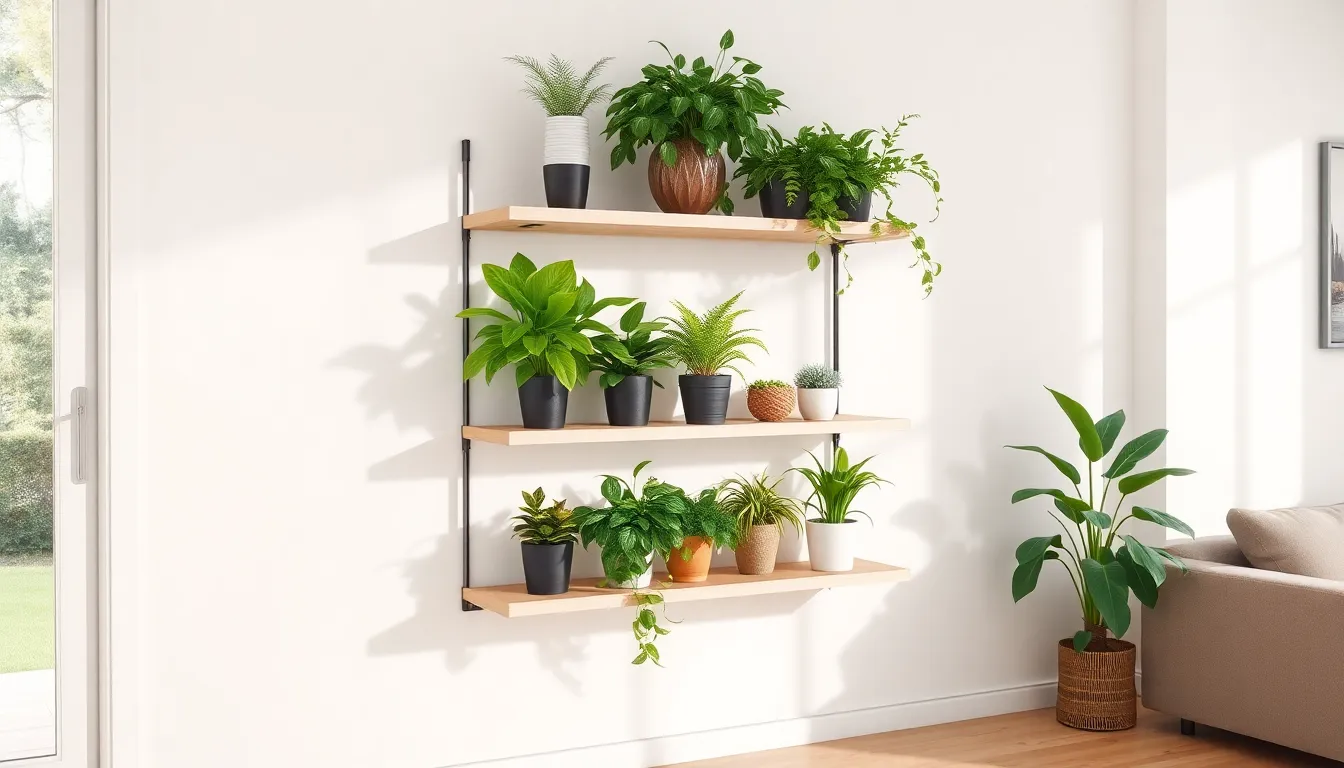
We prioritize household safety when selecting indoor plant shelves, especially in homes with children and pets. Essential safety features protect our families while maintaining beautiful plant displays.
Rounded Edges and Stable Construction
Rounded edges minimize injury risks from accidental bumps or contact, particularly in tight spaces where children play. Metal frames with secure joints and sturdy shelf boards create well-built structures that withstand daily use. Powder coated metal frames combined with non-slip foot pads enhance steadiness while protecting flooring from scratches.
Stable construction features include multi-tiered vertical designs that maximize space while maintaining a balanced center of gravity to reduce tipping chances. Some shelving units incorporate raised baffles on shelves to prevent plants or items from falling off, adding another protective layer. Faux wood veneer surfaces provide durability and easy cleaning without compromising structural integrity.
Anti-tipping devices prove crucial for preventing accidents, with some 3-tier indoor plant stands equipped with two anti-tip brackets or wall anchors. These secure the shelf firmly to walls, preventing accidental tip-overs that could harm family members or damage plants.
Child and Pet-Safe Positioning
Strategic placement away from high-traffic zones reduces exposure risks while keeping plants accessible for care. We position plant shelves in areas where children and pets can’t easily reach or disturb the displays. Height considerations ensure that plants remain out of reach, reducing exposure to potentially toxic varieties.
Wall mounting with anti-tip hardware prevents climbing or pulling accidents that could topple entire shelving units. Secure shelving to walls using proper anchors and brackets, especially for taller or heavier plant collections. This approach safeguards both household members and our valuable plant investments.
Thoughtful height and placement strategies keep potentially harmful plants away from curious hands and paws while minimizing disturbance to plant growth. We consider room layouts and family activity patterns when determining optimal shelf locations, ensuring both safety and plant health remain priorities.
Budget-Friendly DIY Plant Shelf Solutions
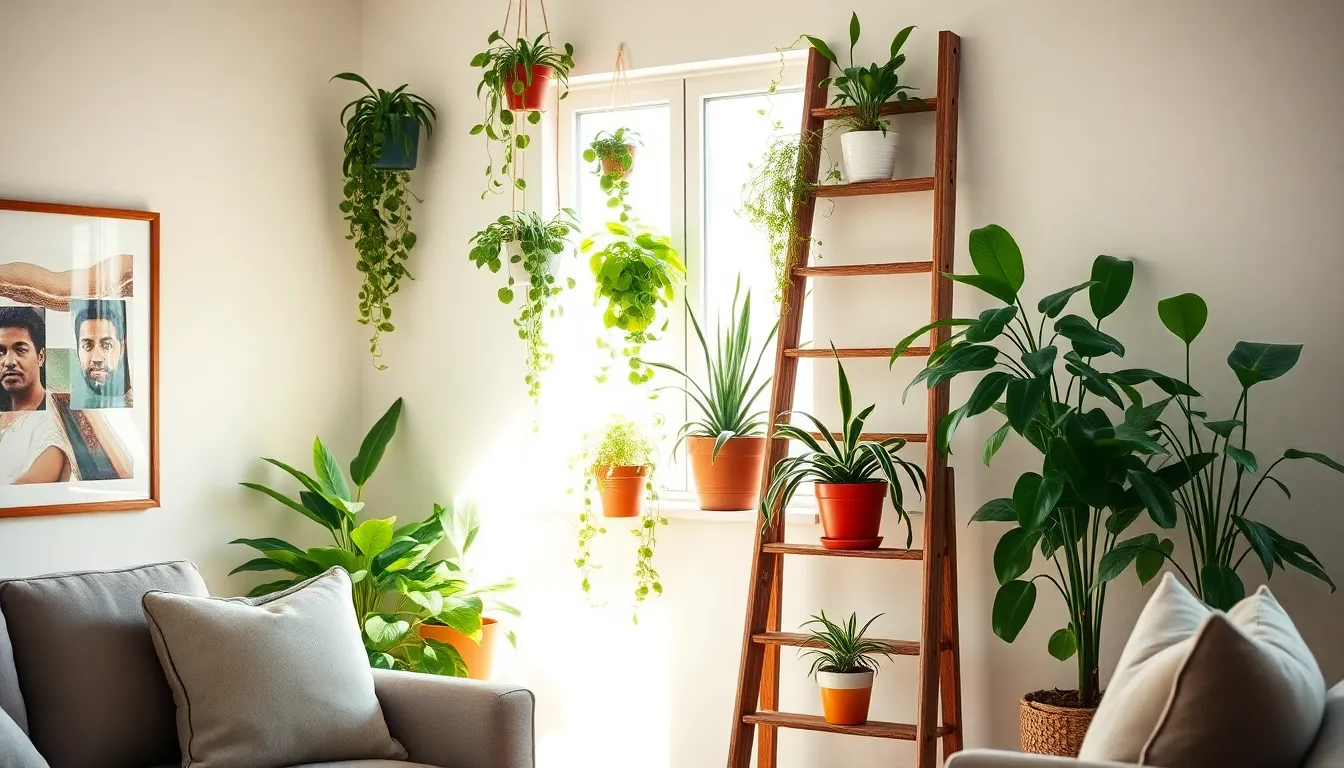
Creating stunning plant displays doesn’t require expensive custom furniture or professional carpentry skills. We’ll explore affordable options that transform everyday items and basic materials into functional plant shelving systems.
Repurposed Furniture Ideas
Bookcases become multi-level plant paradises when positioned strategically throughout your home. Old or secondhand bookcases offer varied shelf heights that naturally accommodate different plant types and sizes, from trailing pothos to tall snake plants. Position these units away from walls to maximize light exposure from multiple angles, ensuring your plants receive optimal growing conditions.
IKEA Expedit bookcases work exceptionally well when turned sideways, allowing light to nourish plants from both sides while creating striking green displays. This simple repositioning transforms a basic storage unit into a sophisticated plant showcase that costs a fraction of custom shelving.
Ladders, crates, and small tables can be upcycled as tiered plant stands that add rustic or eclectic character to indoor green spaces. Wooden step ladders create natural tiers for different sized pots, while vintage crates can be mounted on walls or stacked to form modular displays. Small side tables work perfectly as elevated plant pedestals in corners or beside seating areas.
Floating shelves from IKEA cost under $10 and provide incredible value for plant display needs. These lightweight options can be anchored securely to hold heavy plants when properly installed with appropriate wall anchors. Mount multiple shelves at varying heights to create ever-changing displays that draw the eye upward.
Simple Build Projects for Beginners
Basic wood projects using inexpensive 1×2 lumber require minimal tools and skills while delivering professional looking results. Videos like “DIY Plant Shelves Using 1×2’s” provide step-by-step instructions for creating lightweight, customizable shelves suited for various plant sizes. These boards cost significantly less than premium lumber while still offering adequate strength for most houseplant collections.
Floating shelf attachment proves straightforward for beginners willing to learn basic wall mounting techniques. Choose sturdy wall anchors that support plant weight, especially when pots are watered and become significantly heavier. Locate wall studs whenever possible for maximum holding power and long term stability.
Pre-made plans available online guide beginners through material selection, measurements, and assembly processes to create functional and attractive displays. These resources eliminate guesswork and provide shopping lists that prevent costly mistakes or multiple trips to hardware stores.
Creative arrangement techniques enhance indoor aesthetics without requiring complex woodworking skills. Mix plant heights, textures, and colors to create visual interest that transforms simple shelving into stunning focal points. Group plants with similar care requirements together to simplify maintenance while creating cohesive displays.
Conclusion
Creating the perfect indoor plant display doesn’t have to be overwhelming or expensive. We’ve covered everything from material selection and weight considerations to lighting strategies and safety features that’ll help you build a thriving vertical garden.
Whether you choose sleek metal shelves for a modern look or rustic wooden designs for farmhouse charm your plants will thank you for the thoughtful planning. Remember that proper drainage air circulation and strategic placement are just as important as the shelves themselves.
The best plant shelf system is one that grows with your collection and fits seamlessly into your lifestyle. With these insights you’re ready to transform any space into a lush indoor sanctuary that brings nature’s beauty right into your home.
Frequently Asked Questions
What are the best materials for indoor plant shelves?
The three most popular materials are wood, metal, and glass. Wood provides natural warmth and appeal, with moisture-resistant varieties like cedar and teak being ideal for humid environments. Metal shelves offer modern durability and can support heavy plant collections without sagging. Glass shelves create a minimalist look and maximize light distribution, though they require careful placement to prevent breakage.
How do I calculate the weight capacity needed for my plant shelves?
Calculate the combined weight of pots, soil, and plants, then add a 50% safety margin to accommodate plant growth and watering variations. For proper support, mount shelves into wall studs using heavy-duty anchors for heavier loads. Always test stability after installation to ensure shelves can safely hold the intended weight.
What drainage features should I look for in plant shelves?
Look for built-in drip trays and water management systems that collect excess water during watering. Advanced designs feature angled surfaces directing water into collection buckets, while removable saucers offer flexible drainage options. These features prevent water damage, maintain healthy growing conditions, and make maintenance easier without disturbing plant root systems.
Where should I place plant shelves for optimal light exposure?
Position shelves near windows or under skylights to provide bright, indirect light essential for photosynthesis. Use staggered heights to accommodate different plant sizes and light needs. Choose wire or open material shelves to maximize light penetration and air circulation. In rooms with insufficient natural light, supplement with artificial grow lights.
How can I maximize vertical space with plant shelves?
Use multi-tier designs and floor-to-ceiling ladder shelves that create impressive vertical displays while taking minimal floor space. Corner plant stands optimize overlooked spaces, while adjustable shelving systems adapt to plants’ changing needs. Modular components allow for future expansion without replacing the entire system, making them ideal for growing collections.
How do I choose plant shelves that match my home decor?
For rustic farmhouse styles, select natural wood with distressed finishes and tiered wooden shelves. Contemporary homes benefit from sleek floating shelf designs that create minimalist displays and make spaces appear larger. Consider staggered arrangements for visual interest, and ensure the shelf style complements your existing furniture and color scheme.
What safety considerations should I keep in mind for plant shelves?
Choose shelves with rounded edges, stable construction, and anti-tipping devices, especially in homes with children and pets. Place shelves away from high-traffic areas while maintaining accessibility for plant care. Ensure proper mounting and weight distribution to prevent accidents, and consider the height and positioning to safeguard household members.
Can I create plant shelves on a budget?
Yes, repurpose items like old bookcases, ladders, and crates to create functional plant shelving systems. IKEA floating shelves offer affordable options, while simple DIY projects using basic materials like 1×2 lumber are perfect for beginners. Online resources provide assembly guidance, and creative arrangement techniques can enhance aesthetics without expensive custom furniture.
How important is air circulation for plant shelf design?
Proper air circulation is crucial for plant health and prevents mold and pest issues. Ensure adequate vertical spacing between shelf levels, leaving several inches above each plant. Choose open-back shelf designs to improve ventilation, and avoid overcrowding plants. Adjustable shelving systems allow customization of spacing as your plant collection grows.
What are the benefits of adjustable plant shelving systems?
Adjustable systems adapt to plants’ changing needs throughout their growth cycles, maximizing vertical space efficiency. Customizable height options accommodate varying plant sizes within the same unit, while sliding mechanisms and clip-on spacers enable easy adjustments. Modular components support future expansion, making these systems cost-effective long-term investments for growing plant collections.

